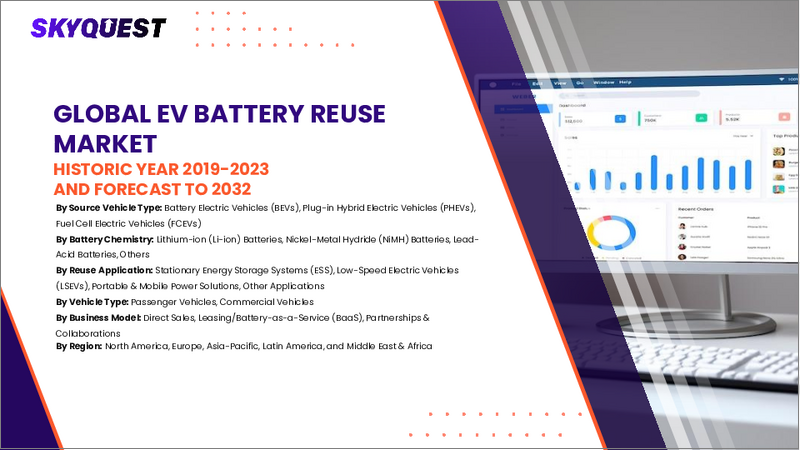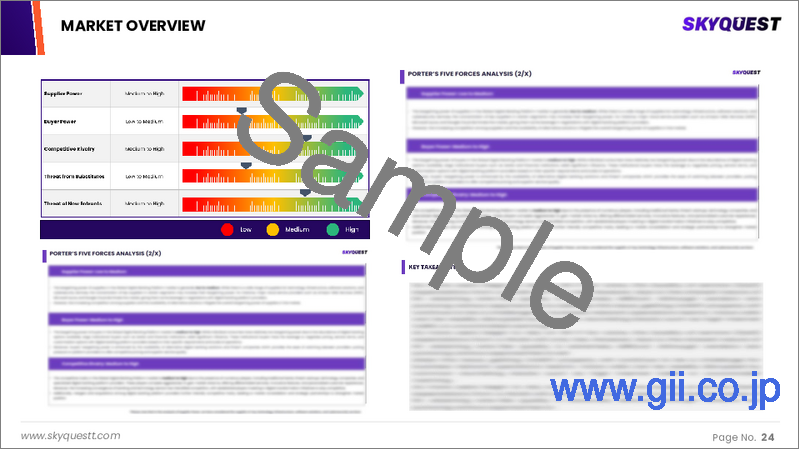|
|
市場調査レポート
商品コード
1658141
EVバッテリー再利用の市場規模、シェア、成長分析:供給源別、バッテリー化学組成別、車両タイプ別、用途別、再利用戦略別、容量範囲別、地域別 - 産業予測 2025~2032年EV Battery Reuse Market Size, Share, and Growth Analysis, By Source, By Battery Chemistry, By Vehicle Type, By Application, By Reuse Strategy, By Capacity Range, By Region - Industry Forecast 2025-2032 |
||||||
|
|||||||
| EVバッテリー再利用の市場規模、シェア、成長分析:供給源別、バッテリー化学組成別、車両タイプ別、用途別、再利用戦略別、容量範囲別、地域別 - 産業予測 2025~2032年 |
|
出版日: 2025年02月15日
発行: SkyQuest
ページ情報: 英文 182 Pages
納期: 3~5営業日
|
全表示
- 概要
- 目次
EVバッテリー再利用の世界市場規模は、2023年に4億6,320万米ドルと評価され、2024年の6億7,720万米ドルから2032年には141億3,497万米ドルに成長し、予測期間(2025~2032年)のCAGRは46.2%で成長する見通しです。
EVバッテリー再利用市場は、持続可能なエネルギー・エコシステムの重要な要素としてますます認識されるようになっており、急成長する電気自動車セクターと、バッテリー廃棄が環境に与える影響を緩和する差し迫った必要性がその原動力となっています。電気自動車用バッテリーは、そのライフサイクルの終わりにかなりの容量を維持することが多いため、エネルギー貯蔵システム、グリッドサポート、再生可能エネルギー統合などのアプリケーションへの再利用に最適です。成長の原動力には、原材料依存度の低減、生産関連の環境フットプリントの最小化、再生可能エネルギーへの移行に伴うエネルギー貯蔵ソリューションの需要急増への対応などがあります。とはいえ、電池の標準化、容量劣化、安全性といった課題にも取り組まなければなりません。利害関係者は、電池の再利用を合理化し、持続可能性を高め、廃棄物を削減するための研究開発と共同イノベーションを優先しています。
目次
イントロダクション
- 調査の目的
- 調査範囲
- 定義
調査手法
- 情報調達
- 二次と一次データの方法
- 市場規模予測
- 市場の前提条件と制限
エグゼクティブサマリー
- 世界市場の見通し
- 供給と需要の動向分析
- セグメント別機会分析
市場力学と見通し
- 市場概要
- 市場規模
- 市場力学
- 促進要因と機会
- 抑制要因と課題
- ポーターの分析
主な市場の考察
- 重要成功要因
- 競合の程度
- 主な投資機会
- 市場エコシステム
- 市場の魅力指数(2024年)
- PESTEL分析
- マクロ経済指標
- バリューチェーン分析
- 価格分析
EVバッテリー再利用市場規模:供給源別
- 市場概要
- バッテリー電気自動車(BEV)
- ハイブリッド電気自動車(HEV)
- プラグインハイブリッド電気自動車(PHEV)
- 燃料電池電気自動車(FCEV)
EVバッテリー再利用市場規模:バッテリー化学組成別
- 市場概要
- リン酸鉄リチウム
- リチウムマンガン酸化物
- リチウムニッケルコバルトアルミニウム酸化物
- リチウムニッケルマンガンコバルト
- チタン酸リチウム
EVバッテリー再利用市場規模:車両タイプ別
- 市場概要
- 乗用車
- 商用車
EVバッテリー再利用市場規模:用途別
- 市場概要
- 低速車両
- 基地局
- EV充電
- エネルギー貯蔵
EVバッテリー再利用市場規模:再利用戦略別
- 市場概要
- 二次利用
- 再利用
- リサイクル
EVバッテリー再利用市場規模:容量範囲別
- 市場概要
- 最大10kWh
- 10~50kWh
- 50~100kWh
- 100kWh
EVバッテリー再利用市場規模
- 北米
- 米国
- カナダ
- 欧州
- ドイツ
- スペイン
- フランス
- 英国
- イタリア
- その他欧州地域
- アジア太平洋地域
- 中国
- インド
- 日本
- 韓国
- その他アジア太平洋地域
- ラテンアメリカ
- ブラジル
- その他ラテンアメリカ地域
- 中東・アフリカ
- GCC諸国
- 南アフリカ
- その他中東・アフリカ
競合情報
- 上位5社の比較
- 主要企業の市場ポジショニング(2024年)
- 主な市場企業が採用した戦略
- 最近の市場動向
- 企業の市場シェア分析(2024年)
- 主要企業の企業プロファイル
- 企業の詳細
- 製品ポートフォリオ分析
- 企業のセグメント別シェア分析
- 収益の前年比比較(2022~2024年)
主要企業プロファイル
- Contemporary Amperex Technology Co., Ltd.(CATL)(China)
- GEM Co., Ltd.(China)
- Umicore(Belgium)
- Glencore(Switzerland)
- Fortum(Finland)
- Redwood Materials(United States)
- Li-Cycle Corp.(Canada)
- Cirba Solutions(United States)
- Accurec Recycling GmbH(Germany)
- Stena Recycling(Sweden)
- Neometals Ltd.(Australia)
- Ascend Elements, Inc.(United States)
- Ecobat(United States)
- Eramet(France)
- SK Innovation(South Korea)
- LG Chem(South Korea)
- Panasonic(Japan)
- BYD(China)
- Northvolt(Sweden)
- Tesla(United States)
結論と提言
Global EV Battery Reuse Market size was valued at USD 463.2 million in 2023 and is poised to grow from USD 677.2 million in 2024 to USD 14134.97 million by 2032, growing at a CAGR of 46.2% during the forecast period (2025-2032).
The EV Battery reuse market is increasingly recognized as a vital element of the sustainable energy ecosystem, fueled by the burgeoning electric vehicle sector and the pressing need to mitigate battery disposal's environmental impacts. As EV batteries often retain substantial capacity at the end of their life cycles, they are ideal for repurposing into applications like energy storage systems, grid support, and renewable energy integration. Growth drivers include reducing raw material dependency, minimizing production-related environmental footprints, and responding to the surging demand for energy storage solutions amidst the transition toward renewable sources. Nevertheless, challenges such as battery standardization, capacity degradation, and safety must be addressed. Stakeholders are prioritizing R&D and collaborative innovations to streamline battery repurposing, enhance sustainability, and reduce waste.
Top-down and bottom-up approaches were used to estimate and validate the size of the Global EV Battery Reuse market and to estimate the size of various other dependent submarkets. The research methodology used to estimate the market size includes the following details: The key players in the market were identified through secondary research, and their market shares in the respective regions were determined through primary and secondary research. This entire procedure includes the study of the annual and financial reports of the top market players and extensive interviews for key insights from industry leaders such as CEOs, VPs, directors, and marketing executives. All percentage shares split, and breakdowns were determined using secondary sources and verified through Primary sources. All possible parameters that affect the markets covered in this research study have been accounted for, viewed in extensive detail, verified through primary research, and analyzed to get the final quantitative and qualitative data.
Global EV Battery Reuse Market Segments Analysis
Global EV Battery Reuse Market is segmented by Source, Battery Chemistry, Vehicle Type, Application, Reuse Strategy, Capacity Range and region. Based on Source, the market is segmented into Battery Electric Vehicles (BEVs), Hybrid Electric Vehicle (HEV), Plug-in Hybrid Electric Vehicle (PHEV) and Fuel Cell Electric Vehicle (FCEV). Based on Battery Chemistry, the market is segmented into Lithium-Iron Phosphate, Lithium-Manganese Oxide, Lithium-Nickel-Cobalt-Aluminum Oxide, Lithium-Nickel-Manganese Cobalt and Lithium-Titanate Oxide. Based on Vehicle Type, the market is segmented into Passenger Cars and Commercial Vehicles. Based on Application, the market is segmented into Low speed vehicles, Base Stations, EV charging and Energy Storage. Based on Reuse Strategy, the market is segmented into Second Life Use, Repurposing and Recycling. Based on Capacity Range, the market is segmented into Up to 10 kWh, 10-50 kWh, 50-100 kWh and > 100 kWh. Based on region, the market is segmented into North America, Europe, Asia Pacific, Latin America and Middle East & Africa.
Driver of the Global EV Battery Reuse Market
The Global EV Battery Reuse market is significantly driven by the rapid growth of electric vehicles, which highlights the importance of sustainable resource management practices. By effectively reusing electric vehicle batteries, we can prolong their operational lifespan, thereby decreasing the need for new raw materials and reducing the overall environmental footprint associated with battery production and disposal. This sustainable approach not only helps in conserving natural resources but also plays a vital role in minimizing the ecological consequences linked to battery waste. As the electric vehicle market continues to expand, the demand for innovative battery reuse solutions is expected to grow correspondingly.
Restraints in the Global EV Battery Reuse Market
The global electric vehicle (EV) battery reuse market faces significant constraints, primarily due to the natural degradation of battery capacity over time, which adversely impacts their overall performance. This degradation presents a challenge in maintaining the quality and reliability of reused batteries, especially in applications where consistent performance is critical. Users and manufacturers may be hesitant to adopt reused batteries if they cannot ensure their effectiveness and longevity. Consequently, addressing these issues is essential for fostering trust and acceptance in the market, ultimately affecting the growth potential of the EV Battery reuse sector on a global scale.
Market Trends of the Global EV Battery Reuse Market
The Global EV Battery Reuse market is witnessing a significant trend driven by the increasing focus on sustainability and circular economy practices. As stakeholders seek to optimize resource utilization, the reconditioning and repurposing of electric vehicle batteries post their primary lifecycle is becoming more prevalent. This trend not only enhances the environmental benefits of EV adoption by reducing waste but also allows for cost-effective energy storage solutions in various applications such as renewable energy integration and grid stabilization. The market's growth is further fueled by regulatory support and technological advancements, positioning battery reuse as a pivotal component of the evolving green economy.
Table of Contents
Introduction
- Objectives of the Study
- Scope of the Report
- Definitions
Research Methodology
- Information Procurement
- Secondary & Primary Data Methods
- Market Size Estimation
- Market Assumptions & Limitations
Executive Summary
- Global Market Outlook
- Supply & Demand Trend Analysis
- Segmental Opportunity Analysis
Market Dynamics & Outlook
- Market Overview
- Market Size
- Market Dynamics
- Drivers & Opportunities
- Restraints & Challenges
- Porters Analysis
- Competitive rivalry
- Threat of substitute
- Bargaining power of buyers
- Threat of new entrants
- Bargaining power of suppliers
Key Market Insights
- Key Success Factors
- Degree of Competition
- Top Investment Pockets
- Market Ecosystem
- Market Attractiveness Index, 2024
- PESTEL Analysis
- Macro-Economic Indicators
- Value Chain Analysis
- Pricing Analysis
Global EV Battery Reuse Market Size by Source & CAGR (2025-2032)
- Market Overview
- Battery Electric Vehicles (BEVs)
- Hybrid Electric Vehicle (HEV)
- Plug-in Hybrid Electric Vehicle (PHEV)
- Fuel Cell Electric Vehicle (FCEV)
Global EV Battery Reuse Market Size by Battery Chemistry & CAGR (2025-2032)
- Market Overview
- Lithium-Iron Phosphate
- Lithium-Manganese Oxide
- Lithium-Nickel-Cobalt-Aluminum Oxide
- Lithium-Nickel-Manganese Cobalt
- Lithium-Titanate Oxide
Global EV Battery Reuse Market Size by Vehicle Type & CAGR (2025-2032)
- Market Overview
- Passenger Cars
- Commercial Vehicles
Global EV Battery Reuse Market Size by Application & CAGR (2025-2032)
- Market Overview
- Low speed vehicles
- Base Stations
- EV charging
- Energy Storage
Global EV Battery Reuse Market Size by Reuse Strategy & CAGR (2025-2032)
- Market Overview
- Second Life Use
- Repurposing
- Recycling
Global EV Battery Reuse Market Size by Capacity Range & CAGR (2025-2032)
- Market Overview
- Up to 10 kWh
- 10-50 kWh
- 50-100 kWh
- 100 kWh
Global EV Battery Reuse Market Size & CAGR (2025-2032)
- North America (Source, Battery Chemistry, Vehicle Type, Application, Reuse Strategy, Capacity Range)
- US
- Canada
- Europe (Source, Battery Chemistry, Vehicle Type, Application, Reuse Strategy, Capacity Range)
- Germany
- Spain
- France
- UK
- Italy
- Rest of Europe
- Asia Pacific (Source, Battery Chemistry, Vehicle Type, Application, Reuse Strategy, Capacity Range)
- China
- India
- Japan
- South Korea
- Rest of Asia-Pacific
- Latin America (Source, Battery Chemistry, Vehicle Type, Application, Reuse Strategy, Capacity Range)
- Brazil
- Rest of Latin America
- Middle East & Africa (Source, Battery Chemistry, Vehicle Type, Application, Reuse Strategy, Capacity Range)
- GCC Countries
- South Africa
- Rest of Middle East & Africa
Competitive Intelligence
- Top 5 Player Comparison
- Market Positioning of Key Players, 2024
- Strategies Adopted by Key Market Players
- Recent Developments in the Market
- Company Market Share Analysis, 2024
- Company Profiles of All Key Players
- Company Details
- Product Portfolio Analysis
- Company's Segmental Share Analysis
- Revenue Y-O-Y Comparison (2022-2024)
Key Company Profiles
- Contemporary Amperex Technology Co., Ltd. (CATL) (China)
- Company Overview
- Business Segment Overview
- Financial Updates
- Key Developments
- GEM Co., Ltd. (China)
- Company Overview
- Business Segment Overview
- Financial Updates
- Key Developments
- Umicore (Belgium)
- Company Overview
- Business Segment Overview
- Financial Updates
- Key Developments
- Glencore (Switzerland)
- Company Overview
- Business Segment Overview
- Financial Updates
- Key Developments
- Fortum (Finland)
- Company Overview
- Business Segment Overview
- Financial Updates
- Key Developments
- Redwood Materials (United States)
- Company Overview
- Business Segment Overview
- Financial Updates
- Key Developments
- Li-Cycle Corp. (Canada)
- Company Overview
- Business Segment Overview
- Financial Updates
- Key Developments
- Cirba Solutions (United States)
- Company Overview
- Business Segment Overview
- Financial Updates
- Key Developments
- Accurec Recycling GmbH (Germany)
- Company Overview
- Business Segment Overview
- Financial Updates
- Key Developments
- Stena Recycling (Sweden)
- Company Overview
- Business Segment Overview
- Financial Updates
- Key Developments
- Neometals Ltd. (Australia)
- Company Overview
- Business Segment Overview
- Financial Updates
- Key Developments
- Ascend Elements, Inc. (United States)
- Company Overview
- Business Segment Overview
- Financial Updates
- Key Developments
- Ecobat (United States)
- Company Overview
- Business Segment Overview
- Financial Updates
- Key Developments
- Eramet (France)
- Company Overview
- Business Segment Overview
- Financial Updates
- Key Developments
- SK Innovation (South Korea)
- Company Overview
- Business Segment Overview
- Financial Updates
- Key Developments
- LG Chem (South Korea)
- Company Overview
- Business Segment Overview
- Financial Updates
- Key Developments
- Panasonic (Japan)
- Company Overview
- Business Segment Overview
- Financial Updates
- Key Developments
- BYD (China)
- Company Overview
- Business Segment Overview
- Financial Updates
- Key Developments
- Northvolt (Sweden)
- Company Overview
- Business Segment Overview
- Financial Updates
- Key Developments
- Tesla (United States)
- Company Overview
- Business Segment Overview
- Financial Updates
- Key Developments






